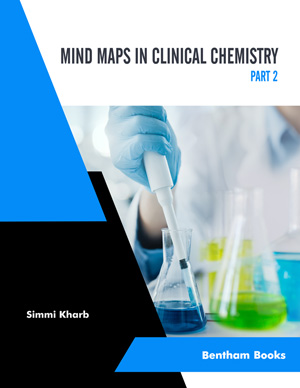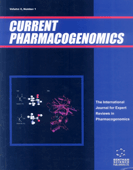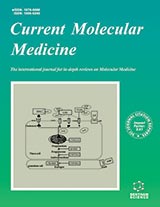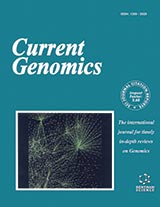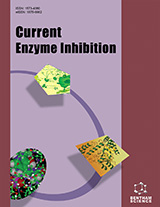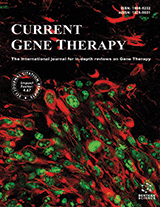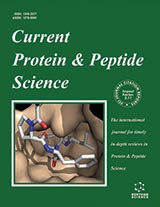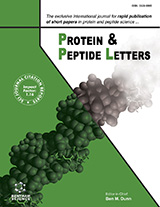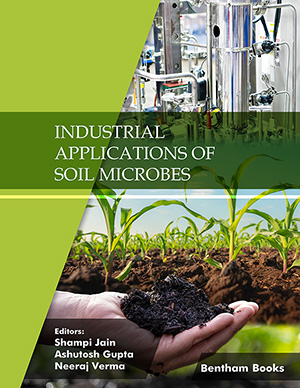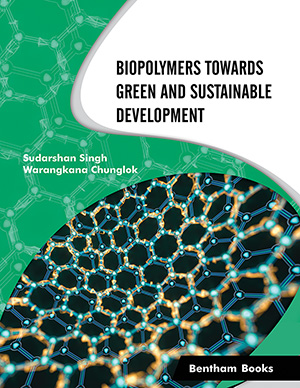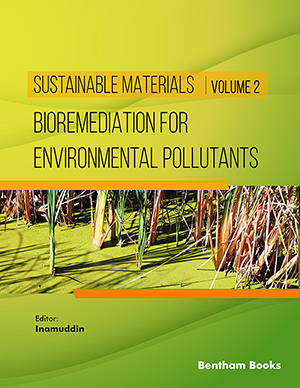Role of Biochemistry in Tumor Detection
Page: 1-11 (11)
Author: Simmi Kharb*
DOI: 10.2174/9789814998758121010002
PDF Price: $15
Abstract
Learning objectives:
1. Enlist Specific Tumor markers for particular cancer.
2. Illustrate different oncogenes and their products.
3. Describe in detail Ectopic production of hormones.
Role of Clinical Laboratory
Page: 12-15 (4)
Author: Simmi Kharb*
DOI: 10.2174/9789814998758121010003
PDF Price: $15
Abstract
Learning objectives:
1. Discuss Outline of Lab work flow.
2. Describe setting of a Clinical Laboratory.
Recent Advances in Clinical Lab
Page: 16-26 (11)
Author: Simmi Kharb*
DOI: 10.2174/9789814998758121010004
PDF Price: $15
Abstract
Learning objectives:
1. Describe Biosensors and Biodetectors.
2. Explain role of Molecular probes in Lab diagnosis.
3. Discuss Nanotechnology.
Automation in Clinical Laboratory
Page: 27-28 (2)
Author: Simmi Kharb*
DOI: 10.2174/9789814998758121010005
PDF Price: $15
Abstract
Learning objectives:
1. Discuss steps for a complete analysis or unit operation.
2. Illustrate systems available for automation.
Clinical Laboratory Information System
Page: 29-30 (2)
Author: Simmi Kharb*
DOI: 10.2174/9789814998758121010006
PDF Price: $15
Abstract
Learning objectives:
1. Illustrate Lab Information system.
2. Explain the importance of Telemedicine.
Role of Clinical Laboratory in Organ Transplantation Program
Page: 31-32 (2)
Author: Simmi Kharb*
DOI: 10.2174/9789814998758121010007
PDF Price: $15
Abstract
Learning objectives:
1. Enlist clinical tests for diagnosis before organ transplantation.
2. Describe Organ Specific Monitoring.
Setting of a Clinical Laboratory
Page: 33-35 (3)
Author: Simmi Kharb*
DOI: 10.2174/9789814998758121010008
PDF Price: $15
Abstract
Learning objectives:
1. Discuss steps in Laboratory design process.
2. Illustrate Hospital laboratory flow diagram.
Various Body Fluids
Page: 36-40 (5)
Author: Simmi Kharb*
DOI: 10.2174/9789814998758121010009
PDF Price: $15
Abstract
Learning objectives:
1. Describe Cerebrospinal fluid.
2. Discuss Synovial fluid.
3. Explain different exudates in body.
Organ Panels
Page: 41-44 (4)
Author: Simmi Kharb*
DOI: 10.2174/9789814998758121010010
PDF Price: $15
Abstract
Learning objectives:
1. Explain Organ panels and related clinical features.
General Laboratory Techniques and Procedures: Introduction
Page: 45-46 (2)
Author: Simmi Kharb*
DOI: 10.2174/9789814998758121010011
PDF Price: $15
Abstract
Learning objectives:
1. Enumerate different instruments and equipments in Clinical chemistry lab.
General Lab Techniques
Page: 47-56 (10)
Author: Simmi Kharb*
DOI: 10.2174/9789814998758121010012
PDF Price: $15
Abstract
Learning objectives:
1. Describe Paper electrophoresis.
2. Discuss about Chromatography and ELISA.
3. Enumerate applications of Radio-isotopes.
4. Explain Mass Spectroscopy, its working, types and applications.
Carbohydrates
Page: 57-64 (8)
Author: Simmi Kharb*
DOI: 10.2174/9789814998758121010013
PDF Price: $15
Abstract
Learning objectives:
1. Illustrate scheme for identification of unknown carbohydrates using different tests.
2. Enlist biologically important carbohydrates.
3. Discuss Osazone crystals.
Abstract
Learning objectives:
1. Describe different tests done for proteins.
2. Explain Protein colour reactions.
3. Discuss Biological value of proteins.
4. Illustrate principle of Protein precipitation.
Milk Analysis
Page: 77-82 (6)
Author: Simmi Kharb*
DOI: 10.2174/9789814998758121010015
PDF Price: $15
Abstract
Learning objectives:
1. Explain physical and chemical analysis of milk.
2. Discuss Biological value of milk.
Urine Exercises
Page: 83-95 (13)
Author: Simmi Kharb*
DOI: 10.2174/9789814998758121010016
PDF Price: $15
Abstract
Learning objectives:
1. Describe characteristics of urine.
2. Describe chemical constituents of normal urine.
3. Explain different abnormal constituents of urine and different methods for estimating these constituents.
Cerebrospinal Fluid (CSF)
Page: 96-98 (3)
Author: Simmi Kharb*
DOI: 10.2174/9789814998758121010017
PDF Price: $15
Abstract
Learning objectives:
1. Describe all characteristics of Cerebrospinal fluid.
Enzyme Activity
Page: 99-107 (9)
Author: Simmi Kharb*
DOI: 10.2174/9789814998758121010018
PDF Price: $15
Abstract
Learning objectives:
1. Explain roles of different enzymes in body- Amylase, Pepsin, Renin, Trypsin.
2. Describe Starch digestion and Protein digestion.
Urea Estimation
Page: 108-114 (7)
Author: Simmi Kharb*
DOI: 10.2174/9789814998758121010019
PDF Price: $15
Abstract
Learning objectives:
1. Describe various methods of urea and creatinine estimation, their clearance properties.
2. Explain the clinical significance of blood urea levels in health and disease.
Creatinine
Page: 115-120 (6)
Author: Simmi Kharb*
DOI: 10.2174/9789814998758121010020
PDF Price: $15
Abstract
Learning objectives:
1. Describe different methods of determination of Creatinine.
2. Discuss Creatinine Clearance.
Abstract
Learning objectives:
1. Discuss methods for estimation of serum Uric acid.
2. Interpret reasons for increased or decreased uric acid.
Glucose (Sugar)
Page: 126-132 (7)
Author: Simmi Kharb*
DOI: 10.2174/9789814998758121010022
PDF Price: $15
Abstract
Learning objectives:
1. Explain different methods for measuring Blood Glucose.
2. Describe Glucose Tolerance Test.
Abstract
Learning objectives:
1. Explain detailed experiment for estimation of total serum bilirubin.
2. Enumerate all other methods for bilirubin estimation.
3. Discuss classification of Jaundice.
Abstract
Learning objectives:
1. Describe determination of total proteins in serum by Biuret method.
2. Interpret different causes of hypoproteinemia and hyperproteinemia.
Alkaline Phosphatase (ALP)
Page: 143-145 (3)
Author: Simmi Kharb*
DOI: 10.2174/9789814998758121010025
PDF Price: $15
Abstract
Learning objectives:
1. Explain estimation of Alkaline phosphatase.
2. Evaluate clinical significance of ALP.
Calcium and Phosphorus
Page: 146-151 (6)
Author: Simmi Kharb*
DOI: 10.2174/9789814998758121010026
PDF Price: $15
Abstract
Learning objectives:
1. Discuss methods for measuring total Calcium and Phosphorus.
2. Interpret causes for increase or decrease of Calcium and Phosphorus.
Abstract
Learning objectives:
1. Describe method for estimation of Serum Amylase.
2. Interpret clinical significance for Amylase estimation.
Cholesterol
Page: 155-161 (7)
Author: Simmi Kharb*
DOI: 10.2174/9789814998758121010028
PDF Price: $15
Abstract
Learning objectives:
1. Explain different methods for determining total Cholesterol.
2. Discuss Applied aspects for Cholesterol estimation.
3. Describe Cholesterol metabolism and uses of cholesterol.
4. Explain drug therapy to lower Cholesterol levels.
Gastric Juice Analysis
Page: 162-173 (12)
Author: Simmi Kharb*
DOI: 10.2174/9789814998758121010029
PDF Price: $15
Abstract
Learning objectives:
1. Discuss composition of Gastric juice and enzymes present in it.
2. Describe Gastric juice analysis to find out its free and total acidity.
3. Explain Gastric Function tests.
4. Interpret results of Gastric juice analysis.
Spectroscopic Examination of Blood
Page: 174-178 (5)
Author: Simmi Kharb*
DOI: 10.2174/9789814998758121010030
PDF Price: $15
Abstract
Learning objectives:
1. Explain Spectroscopic examination of blood.
2. Describe OxyHb, CarboxyHb, MetHb in detail.
Stone Analysis
Page: 179-182 (4)
Author: Simmi Kharb*
DOI: 10.2174/9789814998758121010031
PDF Price: $15
Abstract
Learning objectives:
1. Discuss procedure for Stone analysis.
2. Explain different stones.
Reference range of various parameters in Clinical Lab
Page: 183-186 (4)
Author: Simmi Kharb*
DOI: 10.2174/9789814998758121010032
PDF Price: $15
Abstract
Learning objectives:
1. Describe reference range of various chemical constituents of blood.
Introduction
Mind Maps in Clinical Chemistry presents information about clinical laboratory techniques for junior healthcare professionals, medical residents and students. Each chapter enables readers to suggest, arrange and interpret clinical chemistry tests effectively with the objective of enhancing clinical care. Chapters of this part cover a range of topics focused on biochemical analysis including tumor detection, special topics in clinical biochemistry, the clinical chemistry of diseases, lab instrumentation and reference ranges of diseases. Key Features i. Topic-based presentation through 31 chapters in 6 sections ii. Coverage of practical and theoretical knowledge iii. Lucid and integrated presentation of concepts iv. Wide range of topics covered including tumor detection, special topics in clinical biochemistry, the clinical chemistry of diseases, lab instrumentation, and reference ranges in medical diagnosis v. Packed with practical lab testing information Mind Maps in Clinical Chemistry is an ideal textbook for quick and easy learning of clinical laboratory knowledge for undergraduate and graduate students as well as teachers instructing courses at these levels.


